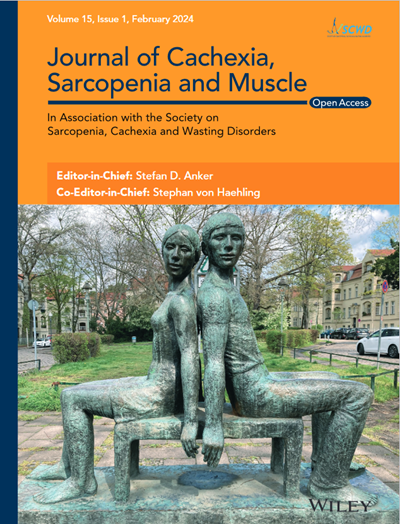Subcutaneous Adipose Tissue Radiation Attenuation Is Associated With Increased 1-Year Mortality in Polytrauma Patients.
IF 9.1
1区 医学
引用次数: 0
Abstract
BACKGROUND Polytrauma patients with an Injury Severity Score (ISS) ≥ 16 have a high mortality rate. Early identification of patients at risk of mortality is key. Different risk stratification models are available; however, body composition on third lumbar computed tomography (L3 CT) is not routinely used. The aim of this study is to determine the effect of CT body composition on 1-year mortality in adult polytrauma patients. METHODS Body composition analysis (L3 CT) was performed on 593 adult polytrauma patients. The associations with 1-year mortality were assessed using uni- and multivariable logistic regression analysis. As a sensitivity analysis, 1-year mortality was analysed using Kaplan-Meier survival curves, log-rank tests and Cox regression. RESULTS The study population was predominantly male (69.5%), with a mean age of 55 (±20) years and an average BMI of 25.34 kg/m2 (±4.07). Comorbidities were present in 327 (55.4%) patients, with an average Charlson Comorbidity Index (CCI) of 2.07 points (±2.1). The mean ISS score was 27.59 (±11.06); 323 (54.5%) patients had an ISS ≥ 25 points. Age, CCI, ISS, skeletal muscle index and skeletal muscle radiation attenuation (OR 1.053, 5.713, 3.711, 0. 563 and 0.533, respectively; p < 0.001), subcutaneous adipose tissue radiation attenuation (SATRA OR 1.253, p = 0.028) and visceral adipose tissue index (OR 1.242, p = 0.038) were significantly associated with 1-year mortality. In multivariable logistic regression, age, ISS and SATRA remained statistically significantly associated with 1-year mortality (OR 1.062, p < 0.001; OR 4.761, p < 0.001; OR 1.396, p = 0.009). CONCLUSIONS This study demonstrated that subcutaneous adipose tissue radiation attenuation on emergency trauma CT scans is significantly associated with 1-year mortality in adult polytrauma patients. Additionally, we found a significant effect of age and ISS on 1-year mortality. Incorporating body composition analysis could lead to a better selection of patients at risk for 1-year mortality and aid in treatment decision-making.皮下脂肪组织辐射衰减与多发创伤患者1年死亡率增加有关。
背景:损伤严重程度评分(ISS)≥16的多发创伤患者死亡率高。及早发现有死亡危险的病人是关键。存在不同的风险分层模型;然而,在第三腰椎计算机断层扫描(L3 CT)上的身体成分不被常规使用。本研究的目的是确定CT体组成对成人多发外伤患者1年死亡率的影响。方法对593例成人多发外伤患者进行体成分分析(L3 CT)。使用单变量和多变量logistic回归分析评估与1年死亡率的关系。作为敏感性分析,采用Kaplan-Meier生存曲线、log-rank检验和Cox回归分析1年死亡率。结果研究人群以男性为主(69.5%),平均年龄55(±20)岁,平均BMI为25.34 kg/m2(±4.07)。327例(55.4%)患者存在合并症,平均Charlson合并症指数(CCI)为2.07分(±2.1)。平均ISS评分为27.59(±11.06)分;323例(54.5%)患者ISS≥25分。年龄、CCI、ISS、骨骼肌指数与骨骼肌辐射衰减(OR: 1.053, 5.713, 3.711, 0;分别为563、0.533;p < 0.001)、皮下脂肪组织辐射衰减(SATRA OR 1.253, p = 0.028)和内脏脂肪组织指数(OR 1.242, p = 0.038)与1年死亡率显著相关。在多变量logistic回归中,年龄、ISS和SATRA与1年死亡率仍有统计学显著相关(OR 1.062, p < 0.001; OR 4.761, p < 0.001; OR 1.396, p = 0.009)。结论本研究表明急诊创伤CT扫描下皮下脂肪组织辐射衰减与成人多发创伤患者1年死亡率显著相关。此外,我们发现年龄和ISS对1年死亡率有显著影响。结合身体成分分析可以更好地选择有1年死亡风险的患者,并有助于治疗决策。
本文章由计算机程序翻译,如有差异,请以英文原文为准。
求助全文
约1分钟内获得全文
求助全文
来源期刊

Journal of Cachexia, Sarcopenia and Muscle
Medicine-Orthopedics and Sports Medicine
自引率
12.40%
发文量
0
期刊介绍:
The Journal of Cachexia, Sarcopenia, and Muscle is a prestigious, peer-reviewed international publication committed to disseminating research and clinical insights pertaining to cachexia, sarcopenia, body composition, and the physiological and pathophysiological alterations occurring throughout the lifespan and in various illnesses across the spectrum of life sciences. This journal serves as a valuable resource for physicians, biochemists, biologists, dieticians, pharmacologists, and students alike.
 求助内容:
求助内容: 应助结果提醒方式:
应助结果提醒方式:


